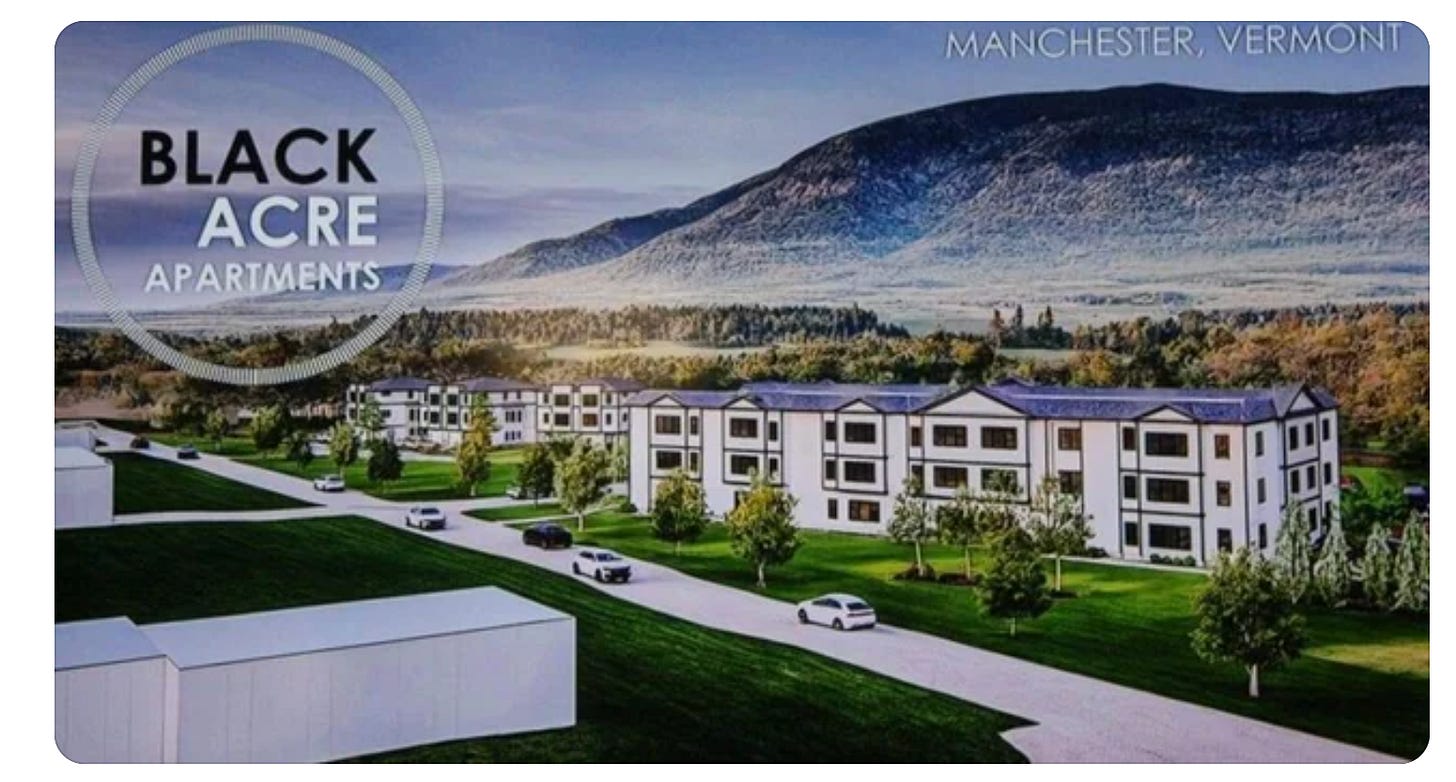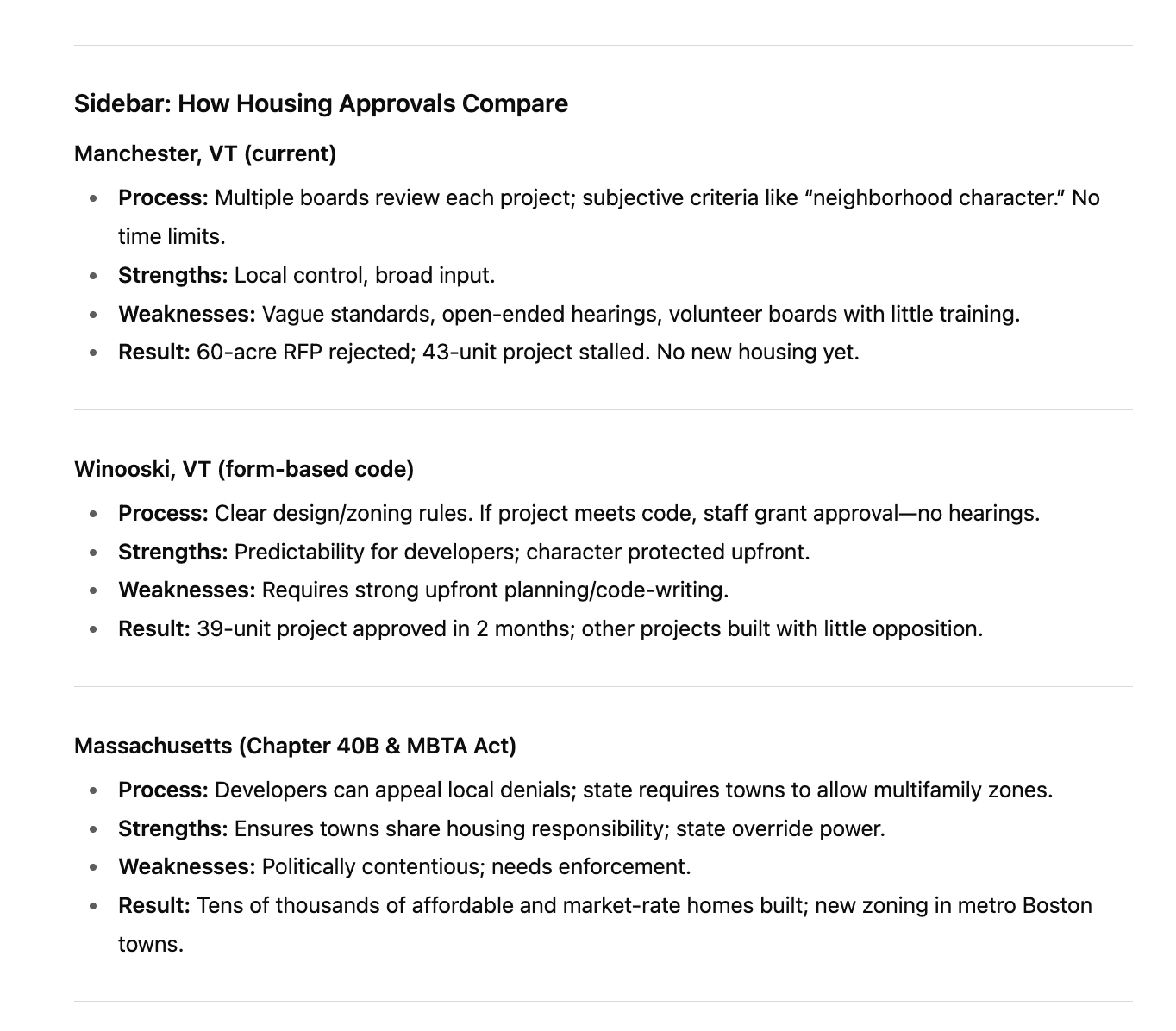Manchester’s Housing Stalemate Shows Why Vermont Needs a Better Approval Balance
When rejections hinge on subjective notions of “neighborhood character,” or when unclear rules invite endless rounds of revisions, the system can feel arbitrary.
Manchester is not alone in struggling with how to add much-needed housing. But the town’s recent experience with two separate projects illustrates how Vermont’s approval process—meant to ensure thoughtful development—can also grind progress to a halt. The result is a growing frustration shared by developers, local leaders, and residents alike: if every project lingers in limbo, Vermont’s housing crisis will never ease.
Two Projects, Two Roadblocks
On one side of town, Manchester officials invited developers to propose housing for a 60-acre town-owned property. Three groups stepped forward with ideas ranging from clustered cottages to a large mixed-income development. Yet the Housing Task Force declined to recommend any of them. Their candid explanation: the town’s request for proposals was too vague about priorities, and each submission came with daunting infrastructure and regulatory challenges. The site sits outside the town’s Act 250 exemption zone, meaning expensive state permitting hurdles, and lacks sewer and water hookups. Instead of moving ahead, the project was sent back for a more detailed RFP.
Up the road, a private developer’s plan for 43 units of workforce housing—permitted under local zoning and exempt from Act 250—ran into a different obstacle. The town’s Design Advisory Board balked, insisting the apartment building and duplexes didn’t “fit the character of the neighborhood.” Even after changes to color schemes, board members remained unsatisfied. The project has since been shunted to another round of hearings, this time with a hydrology study added to the requirements. The developer, who followed the rules laid out in the zoning code, voiced what many feel: just make a decision—approve or deny—so the project can move forward or be appealed.
When Local Oversight Protects, and When It Stalls
Local review boards play a crucial role. Towns should not be forced to accept projects that genuinely threaten safety, overwhelm infrastructure, or disregard clear community standards. In Manchester’s case, concerns about flood hazard areas and the absence of water and sewer lines are valid.
But when rejections hinge on subjective notions of “neighborhood character,” or when unclear rules invite endless rounds of revisions, the system can feel arbitrary. Board members, often volunteers without planning or design expertise, wield significant power over whether housing gets built. That power can be necessary—yet unchecked, it discourages investment and drives up the cost of the few projects that survive.
What a Win-Win Could Look Like
Other communities in Vermont and beyond have shown it’s possible to balance character with speed. Winooski, for example, adopted a form-based code that clearly defines what new buildings should look like and how they should relate to their surroundings. Developers who meet those rules get swift, administrative approval. The city retains its urban character, while housing gets built in months instead of years.
At the state level, Massachusetts’ Chapter 40B and the newer MBTA Communities Act demonstrate another approach: set clear housing obligations for towns, while still giving them flexibility to decide where and how projects fit best. In British Columbia, the provincial government has gone further, assigning binding housing targets and reserving the right to override local slowdowns. These examples all point to a middle path: protect community values upfront through clear standards, but then let projects that comply proceed without delay.
Lessons for Manchester—and Vermont
Manchester’s dual stalemates highlight the broader problem: Vermont’s housing review system is often too open-ended, leading to uncertainty and costly delays. The lesson is not to scrap local input, but to front-load it. If towns want housing that fits their character, they should spell out those expectations clearly in zoning and design codes, then hold developers to them. That way, debates about aesthetics and scale happen when rules are written, not when families are waiting for homes.
Vermont also needs timelines. Developers and residents deserve to know that once an application is complete, a decision will be made within a reasonable window—measured in months, not years. And when towns consistently fail to approve needed housing, state leadership may need to step in, as other jurisdictions have done.
The housing crisis demands urgency. Without reforms, Vermont will keep seeing projects like Manchester’s stall, and the shortage will only deepen. But with clearer rules, faster timelines, and shared responsibility, it’s possible to protect what makes towns like Manchester special while still building the homes that Vermonters need.




